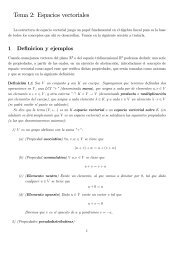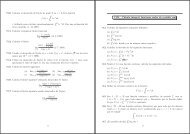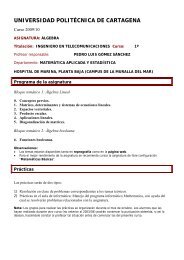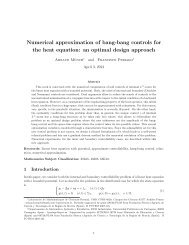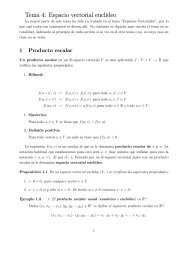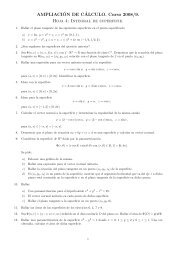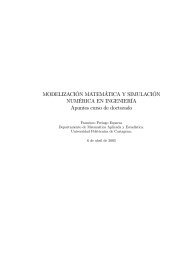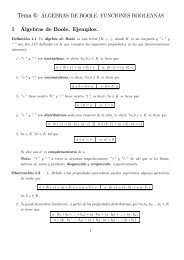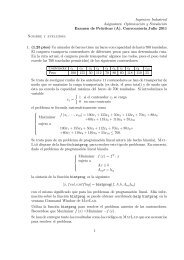Tema 11: Cálculo diferencial de funciones de varias variables I
Tema 11: Cálculo diferencial de funciones de varias variables I
Tema 11: Cálculo diferencial de funciones de varias variables I
You also want an ePaper? Increase the reach of your titles
YUMPU automatically turns print PDFs into web optimized ePapers that Google loves.
Por ejemplo, para una función <strong>de</strong> dos <strong>variables</strong> las <strong>de</strong>rivadas parciales segundas serían∂ 2 f∂x 2∂ 2 f∂x∂y∂ 2 f∂y∂x∂ 2 f∂y 2y las terceras∂ 3 f∂x 3∂ 3 f∂x 2 ∂y∂ 3 f∂x∂y∂x∂ 3 f∂x∂y 2∂ 3 f∂y∂x 2∂ 3 f∂y∂x∂y∂ 3 f∂y 2 ∂x∂ 3 f∂y 3Si f es una función para la que existen todas las <strong>de</strong>rivadas parciales <strong>de</strong> or<strong>de</strong>n k ysoncontinuasenunabiertoΩdiremos que es <strong>de</strong> clase C k (Ω, R) o simplemente <strong>de</strong> clase C k en Ω (diremos que f es <strong>de</strong> clase C ∞ cuando existanlas <strong>de</strong>rivadas parciales <strong>de</strong> todo or<strong>de</strong>n y sean continuas, y <strong>de</strong> clase C 0 cuando la función sea continua). De hecho, las<strong>funciones</strong> usuales y las operaciones que habitualmente realizamos con ellas son <strong>funciones</strong> <strong>de</strong> clase C ∞ en todo punto<strong>de</strong>l interior <strong>de</strong>l dominio. Por ejemplo, así ocurre con la funciónf(x, y) =x 2 e y+x − sin[log( y x )]en todo punto en que x 6= 0e y x > 0.Surge ahora la cuestión <strong>de</strong> si se cumplirá la igualdad <strong>de</strong> las <strong>de</strong>rivadas cruzadas∂ 2 f∂x i ∂x j=∂2 f∂x j ∂x iEsto no es cierto siempre. Pero basta con que la función sea <strong>de</strong> clase C 2 para po<strong>de</strong>r asegurar esto.Ejemplo 3.1 Para la funciónf(x, y) =xe x+2yhallemos las <strong>de</strong>rivadas <strong>de</strong> primer, segundo y tercer or<strong>de</strong>n. Las <strong>de</strong> primer or<strong>de</strong>n sonf x = e x+2y + xe x+2y =(1+x)e x+2yf y =2xe x+2ylas <strong>de</strong> segundo or<strong>de</strong>n sonf xx = e x+2y +(1+x)e x+2y =(2+x)e x+2y f xy = f yx =2(1+x)e x+2y f yy =4xe x+2yy las <strong>de</strong> tercer or<strong>de</strong>n sonf xxx =(3+x)e x+2y f xxy = f xyx = f yxx =2(2+x)e x+2y f xyy = f yxy = f yyx =4(1+x)e x+2y f yyy =8xe x+2yNota: Observemos que hemos utilizado que f es C ∞ para justificar las igualda<strong>de</strong>sf xy = f yx ,f xxy = f xyx = f yxx ,f xyy = f yxy = f yyxEjemplo 3.2 Para la funciónf(x, y, z) =xy cos(2x − 3z) − sin(y 2 + x 2 )hallemos las <strong>de</strong>rivadas <strong>de</strong> primer y segundo or<strong>de</strong>n. Las <strong>de</strong> primer or<strong>de</strong>n sonf x = y cos(2x − 3z) − 2xy sin(2x − 3z) − 2x cos(y 2 + x 2 )f y = x cos(2x − 3z) − 2y cos(y 2 + x 2 ) f z =3xy sin(2x − 3z)Las <strong>de</strong> segundo or<strong>de</strong>n sonf xx = −4y sin(2x − 3z) − 4xy cos(2x − 3y) − 2cos(y 2 + x 2 )+4x 2 sin(y 2 + x 2 )f xy = f yx =cos(2x − 3z) − 2x sin(2x − 3z)+4xy sin(y 2 + x 2 ) f xz = f zx =3y sin(2x − 3z)+6xy cos(2x − 3z)f yy = −2cos(y 2 + x 2 )+4y 2 sin(y 2 + x 2 ) f yz = f zy =3x sin(2x − 3z) f zz = −9xy cos(2x − 3z)8



